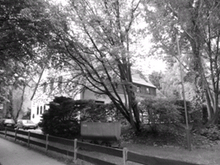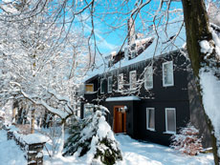Agricola Academic Association
|
Agricola Academic Association |
|
|---|---|
| coat of arms | Circle |

|

|
| Basic data | |
| University / s: | RWTH Aachen , FH Aachen , TU Clausthal |
| Founding: | December 10, 1878 |
| Place of foundation: | Berlin |
| Corporation association : | No umbrella association |
| Abbreviation: | AV |
| Colours: |
|
| Position to the scale : | not striking |
| Motto: | For law and truth |
| Total members: | 263 (as of 2020) |
| Active: | 17 (Clausthal) 24 (Aachen) (as of 2020) |
| Website: | www.agricola.de |
The Agricola Akademischer Verein eV was founded as the Academic Association Schlägel und Eisen on December 10, 1878 at the Bergakademie Berlin as a student association for miners and smelters. Schlägel und Eisen shows many parallels to the older Berg- und Hüttenmännischer Verein . In addition to joint festivities and professional cooperation, the relationship between the two groups was characterized by mutual competition.
The name goes back to Georgius Agricola , the founder of the geosciences . Today it is divided into two sub-associations, the AV Agricola Aachen and the AV Agricola Clausthal, as well as the AV Agricola Essen sponsoring association. The two sub-associations are freely accessible to male students studying natural sciences and engineering . Members who have already graduated from the other two locations are accepted into the AV Agricola Essen sponsoring association. The AV Agricola is emphasized study oriented, not hitting , not color-supporting , dachverbandslos and apolitical.
Due to its dual character as a connection and professional association, the association is one of the central networks of the German coal and steel industry and was particularly important in the early years of the Federal Republic. The members, for example, belonged to the specialist civil service as mining assessors and were thus clearly differentiated from classic academics and liberal professions, as was the case with the specific mining self-image. The close internal ties through the student connections at the ABC locations in Aachen, Berlin and Clausthal - including the Academic Association Schlägel und Eisen - in combination with the strong professional self-confidence and a pronounced festival culture led to an exclusive sense of togetherness and corps spirit .
Locations
The Academic Association Agricola has active locations in Aachen and Clausthal-Zellerfeld . There are club houses at both locations , which offer both private and common rooms for the resident students. The club houses are used for lecture series or parties. The old gentlemen's association (AV Agricola Essen) has its headquarters in Essen and organizes the entire association from there. Round tables have been formed in different regions of Germany , where members resident in the vicinity maintain contact. The clubs are part of the tradition of the universities as well as the cities at the respective locations.
Selection of outstanding members
Many members also earned merit in their later professional life and gave the association recognition and prestige. Member Franz Adolf Fürer, who is number 1 in the perpetual membership list, is the author of the last major German-language reference work on salt mining and salt research.
Member # 2. Georg Gothein rose in the Weimar Republic to Reich Minister of the Treasury on. After working as a mountain consultant and mountain assessor, he was secretary general of the Upper Silesian Mining and Metallurgy Association from 1885 to 1887. In 1918 he was one of the founders of the DDP. Gothein represented a consistently liberal democratic policy and took a committed stand against militarism and anti-Semitism.
The recent honorary president of the Federation of German Industries, Hans-Günther Sohl, who died in 1989, is representative of numerous members in outstanding positions in business, public life, and research and teaching . He owes the connection as a profession-specific circle to advocacy and support in career entry and other stations
Coat of arms and compasses
The coat of arms and the circle of the association are traditional symbols and identifying marks of the couleur student. Nowadays they are only used in the context of maintaining tradition. The coat of arms shows the tenacity of the miners and smelters, as well as the heraldic animal of the founding city, the Berlin bear and the founding date of the AV Agricola. The circle is the monographic representation of the motto "Vivat, Crescat, Floreat!" - Latin for "Live, grow and bloom!"
history
founding
The AV Agricola was founded on December 10, 1878 by eight mining students from the Bergakademie Berlin under the name “Academic Association Mallets and Iron”. The aim of the association at that time was to found a professionally specialized organization of prospective and graduated academics . The external reason for founding the association was the noticeable increase in the number of students due to the economic upswing after the establishment of the Reich in 1871, who felt that they were insufficiently represented in the newly founded student committee . A club member was elected to this committee for the first time in the summer semester of 1879. In the period that followed, members of the association repeatedly took on positions in student self-administration . Numerous Asta chairmen and members, student council chairmen , members of student parliaments and other comparable institutions were members of the association.
The important role of the association as a social network of the members as well as in the interaction with other mining student associations and professional associations can be seen, among other things, from a large number of archive materials in the archive of the German Mining Museum in Bochum . According to Barbara Dorothea Michels (2012), the most important German mining association, the Mining and Metallurgy Association , had, in addition to relationships with corps such as the Corps Montania Clausthal and the Turnerschaft Rheno-Borussia Aachen , above all an intensive exchange with professionally organized associations such as the AV Agricola. The BuHV in Bochum contains numerous examples of contacts to the AV Agricola (formerly Schlägel und Eisen) and great solidarity.
Organization development
In 1888 the association already consisted of 44 old men and 31 active members . In order to better organize the old men , the “Committee of the Old Men” was founded this year. After the first foundation festival , the AV mallets and irons appeared increasingly in public. In 1903, the AV rented its first pub rooms and furnished them with their own interior. With the beginning of the First World War in 1914, the life of the association came to a standstill as much as possible, as the majority of the members were drafted. The rented pub rooms were also given up. After the First World War in 1918, due to numerous losses, the association only consisted of 8 active members and 160 old men. Nevertheless, club life was resumed. In 1926, AV Schlägel und Eisen acquired a three-story house at 20 Englische Strasse in Berlin. This was the first AV property that was inhabited by part of the active population. With the announcement of the new National Socialist student law in 1934, all students were forced to join the German student body , which has been controlled by the National Socialist German Student Union since 1931 . Under pressure from the National Socialist Student Union, the AV Schlägel und Eisen, together with the Berg- und Hüttenmännischer Verein, founded the mining comradeship in 1935 in order to create an alternative to the NSDStB . However, the mining comradeship was also incorporated, which prompted several members to resign from the association. On November 22, 1943, Allied aerial bombs hit the house in Berlin and completely destroyed it.
Second World War to 1968
At the end of the Second World War , in autumn 1945, attempts began to revive the club life. They met in private apartments in the Ruhr area and demonstrated the cohesion of the AV mallet and iron. At that time the corporation “AV Mallets and Irons” did not officially exist. The organizational re-establishment (the old rulers ) took place on May 21, 1948 in Essen under the name "Academic Association Mallets and Iron". The main goal of supporting the students at RWTH Aachen University and at the Clausthal mining academy was defined, among other things, with a newly drafted statute . However, due to a designation of the university officers (officers of the occupying powers at the individual universities) it was forbidden to choose the same name, as it was already used by another corporation. So it was unanimously decided to use the name "AV Agricola" based on the universal scholar Georgius Agricola . In 1948 it was decided to provide one house each for the two locations in Aachen and Clausthal. In September 1950 a house in Clausthal was acquired by the occupying forces and made available to the AV Clausthal. In Aachen, a plot of land in the immediate vicinity of the main RWTH building, on the Königshügel, was acquired and a house was built.
This could be handed over to Aktivitas on November 16, 1951. Old men who studied in Berlin before the Second World War and were active there suggested the idea of reopening an Aktivitas in Berlin. A third Aktivitas was founded there in November 1954 and an intensive exchange between the three locations developed. In 1959 a club-owned house was inaugurated in Berlin. The first ABC-Convent (Aachen Berlin Clausthal - Convent) was held in 1957 and a joint statute for all three associations was decided. The amalgamation of the subject-specific student associations runs parallel to the closely coordinated mining industry training courses of the three universities ( large ABC of training: Aachen, Berlin and Clausthal ) and is also reflected in the professional associations such as the GDMB . The great international popularity of the three technical universities, especially Clausthal, is still due to the fact that the "ABC universities" are internationally established as an industry term.
During this time there were more discussions about the goals and priorities of the association. After long discussions, it was agreed to adapt to the society that has been changed by change and progress. For example, the unconditional satisfaction obligation was lifted, and the introduction of the duz comment and a more relaxed approach to the previously much more formal beer comment was decided. At the beginning of the coal crisis (1958), the number of students in the mining subject fell sharply at all three university locations. This also had an impact on the youngsters at the AV Agricola. The particularly strong “ student revolution ” of the 68s in Berlin prompted the board of the old gentlemen's association to include an addition to the statutes: “Membership is independent of religious affiliation or political attitudes of the person; However, it presupposes that the member affirms the existing democratic social order of the Federal Republic of Germany. ”Despite this early liberalization , no viable active community could be maintained at the Berlin location. The club house was closed and sold at the beginning of the 1970s.
1968 to 1990
In the course of the coal crisis, new enrollments for the subjects mining and metallurgy continued to decline sharply. The universities in Aachen and Clausthal undertook extensive restructuring in view of these changes . New subjects in the natural sciences and engineering were introduced which immediately enjoyed strong demand from students. The restructuring also had an impact on the AV Agricola, as the number of potential members (prospective miners and smelters) at the universities decreased. Despite some protests, it was decided that as of winter semester 1968/69 for the first time students from the technical and scientific disciplines could be included. Despite the innovations, the traditional mining property was still maintained. In 1976 the common concern of BuHV, Agricola and other mining associations at the Association of Supporters of Mining and Metallurgy at the Technical University of Berlin eV from 1976, formerly the association “Alter Berliner Bergakademiker e. V. zu Berlin ”emphasizes once again that Hans-Günther Sohl was one of the top people at Agricola in this context.
1990 until today
Student associations increasingly found negative associations among the public and the association, which continued to be dominated by mining, suffered from a lack of young talent due to the structural change in the mining industry . As a result, a working group was set up in the 1997/1998 winter semester to determine the identity and future direction of the association. Both excursions to companies and semester events such as lectures and seminars were anchored in the semester programs. Primarily, a quick and successful study of the activities in Aachen and Clausthal should be made possible. These goals were voted on in 1998, which led to the constitution of the new statutes on March 5, 1999. This changed the AV Agricola into its current form. In order to deepen the international exchange, a partnership was established in 2010 with the Omega Chapter of the Delta Phi (ΔΦ) Fraternity in Pittsburgh, which is also committed to the mining tradition . Delta Phi was founded in 1827 and, along with the Kappa Alpha Society and Sigma Phi Society, belongs to the Union Triad , making it one of the oldest student associations in the United States. In addition to the classic liaison activities, the association also organizes vocational excursions, in recent years also increasingly abroad (including Sweden, Poland, Hungary, Italy and England). Visits to extraordinary construction projects as well as large and medium-sized companies are also offered and supported by the old men who work there.
literature
- Agricola, Academic Association Essen: 130 years of the Academic Association Agricola , Kempen, 2008 ( online ).
- Helmut Burckhardt: History of the Academic Association Schlägel and Eisen zu Berlin: 1878-1928 , 1928
- Hermann Schrader: 75 years of AV Schlägel und Eisen , 1953.
- Michael Doeberl et al. (Ed.): Das akademische Deutschland, Volume 2: The German universities and their academic citizens, Berlin 1931.
- Walter Koska: 110 years of AV Schlägel und Eisen , Kempen, 1988.
Individual evidence
- ↑ 77th Bulletin AV Agricola, March 2020, pp. 58/59.
- ^ EH Eberhard: Handbook of the student liaison system. Leipzig, 1924/25, p. 122.
- ^ A b c d e Barbara Dorothea Michels: Specialized civil servants and civil society: The mining and smelting association. Dissertation at the Ruhr University Bochum 2012 (PDF; 27.3 MB), p. 139.
- ↑ Barbara Dorothea Michels: Specialized civil servants and civil society: The mining and smelting association (p. 139) quotes AV mallets and iron (ed.): 110 years of AV mallets and iron. History of the Academic Association Schlägel und Eisen 1878 to 1988. Michael Farrenkopf , Between middle class, civil servant status and professional orientation. The higher Prussian mining officials in the second half of the 19th century, in: DER ANSCHNITT 47, 1995, pp. 2–25.
- ↑ Festschrift for the 175th anniversary of the Clausthal Mining Academy, 1775–1950: Festbericht, Clausthal Mining Academy, 1951
- ^ Aachen from A to Z: Interesting facts in 1500 key words about history, art and culture, Holger A. Dux , Aschendorff Verlag, 2003
- ^ Franz Adolf Fürer . Salt mining and salt works. 2 volumes. Braunschweig 1900. Reprint: Hildesheim 1998. With an afterword by Hans-Henning Walter.
- ^ German entrepreneurs between the war economy and reconstruction: Studies on the experience of industrial elites, by Paul Erker, Toni Pierenkemper, Oldenbourg Verlag, 1999, p. 58
- ↑ Sandra Markus: Accounting and Creating Meaning: Memories of Entrepreneurs in the 20th Century , p. 215
- ↑ BBA: 89/213, quoted from Barbara Dorothea Michels: Fachbeamtentum and civil socialization: The mining and smelting association. P. 139.
- ↑ Academic Speeches - Volumes 32–43 - Page 25, Technische Universität Berlin - 1966
- ^ Society for Mining, Metallurgy, Raw Material and Environmental Technology GDMB, see Erzmetall, Volume 37, Dr. Riederer-Verlag, 1984
- ↑ Wirtschaftswoche - Rush to the Harz Mountains, University Statistics 2010 , accessed on May 11, 2012
- ↑ Visiting: From Canton to Clausthal , in: zeit.de , accessed on July 25, 2013
- ↑ Beer Comment of the Academic Association Schlaegel and Eisen, Academic Association Schlägel and Eisen (Berlin), 1909
- ↑ Glückauf, Volume 117, Issues 7-11, Verlag Glückauf, 1981
- ↑ 70. Bulletin AV Agricola, 2013, p. 34 ff.

